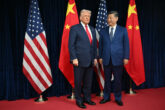September 17, 2018
Why China Is Brutally Suppressing Muslims
The assault on the Uighurs serves Beijing’s imperial ambitions, which require stable land borders.
The repression of the Turkic Uighur Muslim community in western China—including the reported internment of up to a million people in secret camps—is a key part of Beijing’s new imperial policy. Only by understanding the dynamics of Chinese empire can one grasp this brutal campaign.
Xinjiang, a province home to millions of Uighurs, translates to “New Dominion.” The area has been historically and geographically known as East Turkestan. Though the Chinese state has existed for more than 3,500 years, Xinjiang first became part of China’s Qing Dynasty only in the mid-18th century. Since then it has often been in a condition the British explorer Fitzroy Maclean labeled as “sustained turbulence.”
When I first traveled through Xinjiang and interviewed Uighurs in 1994, their hatred of what they considered ethnic Han Chinese occupiers was complete. “This is Turkestan, not China. Chinese don’t learn our language, and many of us don’t learn theirs. Even on a personal level, relations are bad,” one young Uighur man told me.
Relations have worsened since. A deep, unspoken reason why China has never liberalized is its authoritarian leadership fears ethnic rebellion. Uprisings of this sort happened in the outer reaches of the Soviet Union after it liberalized in the 1980s. So China has kept its political system closed, while simultaneously pushing into Central Asia through diplomacy and economic interventions. It is building vast infrastructure projects in the region to ally with the Turkic Muslims of the former Soviet Union and deny China’s own Muslims a friendly rear base for future rebellion. China’s push beyond its borders ultimately has to do with demons within.
Because China historically has never been secure on land, particularly in this western region, it has not had the luxury of going to sea. Except for the Indian Ocean exploits of Adm. Zheng He during the early Ming Dynasty, China has had a demonstrably weak naval tradition. Yet China, mostly secure on land today, aims to posses the world’s largest navy. The intensifying suppression of the Uighur Muslims is the final act in this process. The Belt and Road Initiative—forging transportation corridors by land and sea across Eurasia—requires the complete subjugation of the Uighur population.
Read the Full Article at The Wall Street Journal
More from CNAS
-
North Korea Reveals Troop Dispatch to Russia amid U.S.-South Korea Policy Talks
North Korea has confirmed for the first time that its troops are operating in Russia, and it is preparing to rewrite its party charter with the possibility of officially namin...
By Dr. Go Myong-Hyun
-
Chinese Maker of Bitcoin-Mining Machines Is a Security Threat, Says Expert
Bloomberg News reports that a Chinese manufacturer, Bitmain Technologies Ltd, that sells most of the world’s Bitcoin-mining machines — including 16,000 of them to a venture ba...
By David Feith
-
Indo-Pacific Security / Energy, Economics & Security
North Korea’s Provocations, Power Plays, and Shifting AlliancesTensions on the Korean Peninsula have reached a new and dangerous threshold. President Lee Jae Myung is warning of a real risk of accidental military clashes, as the situation...
By Dr. Go Myong-Hyun
-
Indo-Pacific Security / Energy, Economics & Security
How to Win the Economic War with ChinaTrump's approach to China has run aground, giving Beijing unprecedented advantage in the economic conflict....
By Edward Fishman & Julian Gewirtz



